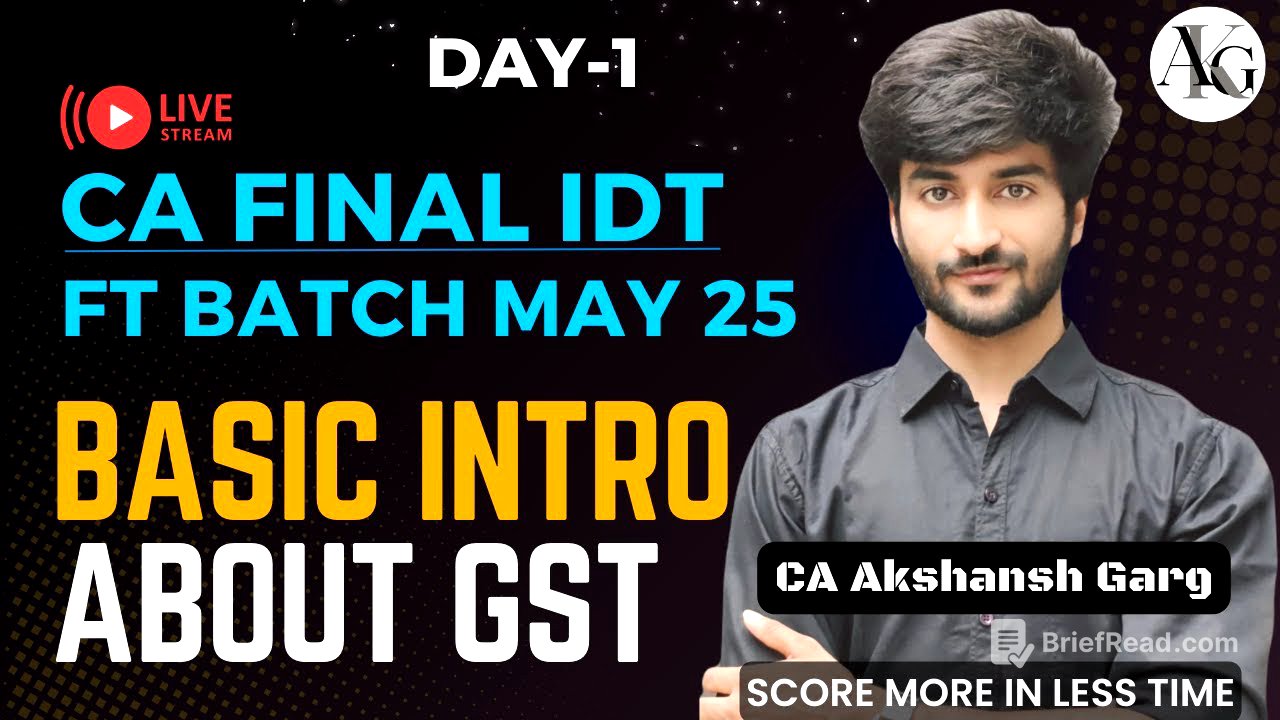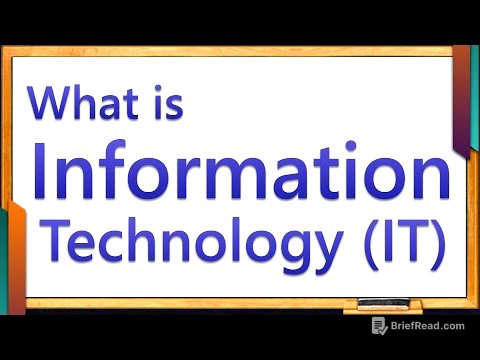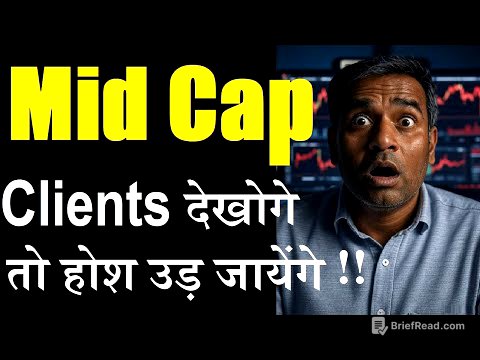TLDR;
This video is a lecture by CA Akshansh Garg providing an overview of Indirect Tax (IDT), focusing on Goods and Services Tax (GST). The lecture outlines the structure of the course, expectations from students, and a detailed explanation of the evolution of GST in India, including the problems with previous tax systems like VAT and CST. It also covers the constitutional aspects of GST, the GST Council, and the concept of India as a federal state.
- Course structure and expectations
- Evolution of GST in India
- Constitutional aspects of GST
- GST Council and its functions
- India as a federal state
Course Structure and Expectations [0:28]
The lecture is a live session expected to run from January 8th to around January 25th or the end of February. While the sessions are primarily live, recordings will be provided, with a maximum of three to four recorded sessions anticipated. Classes will typically start around 7:35 AM and last until 10:30 AM, including a short break. Students will have access to 1.5x speed recordings for later viewing. The instructor emphasizes the importance of attending live sessions for better learning and discipline. This is the 22nd batch, and the instructor prefers live classes to ensure consistent learning and better results for students.
Consistency and Syllabus Coverage [1:16]
The instructor expects students to attend live classes and revise the material for at least 20 minutes each day. There will be regular class tests to ensure discipline and preparation. The IDT paper pattern includes GST (80 marks) and Customs & FTP (20 marks). The GST portion is further divided into practical concepts (50-55 marks) and theory (25-30 marks). The majority of class time will be dedicated to practical GST concepts, specifically chapters 2 to 9, which cover approximately 70% of the syllabus.
Books and Telegram Channel [7:15]
Two books will be provided: a summary book (350 pages) and a question bank (520 pages), both based on ICAI material. These books are designed to facilitate revision in the last 1.5 days before the exam. Students are advised to join the Telegram channel for updates, notes, and direct communication with the instructor.
Tax Fundamentals and Types [21:14]
Tax is a compulsory charge, with two types: direct and indirect. Direct tax is levied directly on income, affecting the taxpayer immediately, while indirect tax is levied on goods and services, collected by intermediaries, and does not directly depend on income. Direct tax is progressive, increasing with income, whereas indirect tax is regressive, remaining the same regardless of income. GST is an indirect tax levied on turnover, not profit, and is a major source of revenue for the Indian government.
The Genesis of GST: Addressing the Shortcomings of VAT and CST [26:26]
Before GST, there was VAT (Value Added Tax) and CST (Central Sales Tax). The major issues with the previous tax system were tax on tax and double taxation. The lecture explains with examples how these issues led to increased prices and inflation. VAT was introduced in 2004 to address these problems by giving credit for taxes already paid.
VAT and CST: Problems and Solutions [39:34]
VAT aimed to remove tax on tax and double taxation by not carrying forward the tax amount and providing cashback for taxes paid earlier. However, VAT was a state tax, leading to issues in interstate transactions. CST was introduced for interstate sales, but it created complexities and disputes between states. The selling state would get the tax, leading to imbalances and the need for a more unified system.
Case Studies Illustrating VAT and CST Issues [56:54]
Three case studies are presented to illustrate the problems with VAT and CST. These cases involve scenarios where goods are sold within the same state and across different states, highlighting issues such as double taxation and the complexities of tax credits. The main problem was that the states had conflict with each other and there was no collaboration between the center and state.
The Road to GST: Constitutional Amendments and Political Consensus [1:20:48]
The introduction of GST required constitutional amendments, necessitating a two-thirds majority in both the Rajya Sabha and Lok Sabha, along with the President's signature. The idea to bring GST was from the year 2000, but it was not possible due to lack of political consensus. The BJP government, with key figures like Arun Jaitley, played a crucial role in building consensus and marketing the benefits of GST.
GST Implementation: A Story of Political Will and Economic Reform [1:39:00]
GST was passed in the Lok Sabha in 2015 but faced resistance in the Rajya Sabha. Extensive marketing and political pressure led to its passage in the Rajya Sabha on August 8, 2016. The President signed the Constitution in September 2016, and GST was launched on July 1, 2017. Jammu and Kashmir adopted GST on July 8, 2017, due to Article 370. India adopted the GST model from Malaysia and is among 160 countries with GST.
Article 370 and the Federal Structure of India [1:42:39]
The lecture discusses the historical context of Article 370, which granted special status to Jammu and Kashmir. Before independence, India comprised 565 princely states, and Sardar Vallabhbhai Patel played a key role in merging these states into India. Three states—Junagadh, Hyderabad, and Jammu & Kashmir—initially resisted merger. The unique conditions under which Jammu and Kashmir merged led to Article 370, which imposed conditions on the laws applicable to the state.
GST Models and the Indian Context [2:02:46]
There are three GST models: single, dual with single control, and dual with dual control. India follows the dual GST model with dual control, where both the central and state governments jointly take decisions and share revenue. This model reflects India's federal structure, where no government is superior to the other. CGST and SGST are levied at 50% each, ensuring equal power and revenue distribution between the central and state governments.
Destination-Based Tax and the GST Council [2:07:22]
GST is a destination-based tax, meaning the revenue goes to the state where the goods or services are consumed. The lecture explains why exports are not subject to GST and imports are. For GST purposes, India includes 31 states and five Union Territories (Delhi, Puducherry, and Jammu & Kashmir are treated as states). The GST Council, comprising representatives from the central and state governments, makes key decisions regarding GST rates and policies.
Revenue Concerns and the GST Compensation Cess [2:13:58]
The state governments were initially concerned about potential revenue losses due to GST. To address this, the GST Compensation Cess Act was introduced, ensuring states would be compensated for any revenue shortfall for the first five years (later extended to 2027). This compensation is funded through a cess levied on luxury and demerit goods, ensuring that wealthier consumers contribute to supporting states facing revenue losses. The lecture concludes by emphasizing the collaborative nature of the GST system and the importance of understanding its historical and constitutional context.









